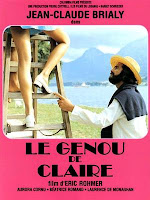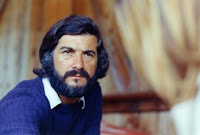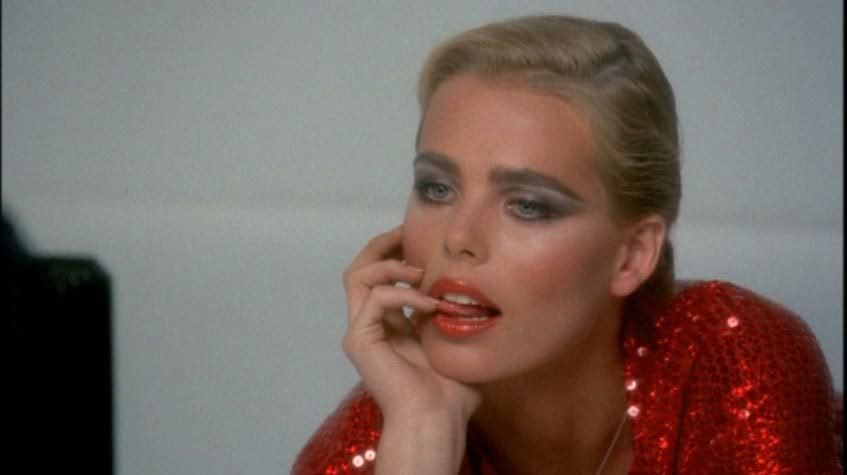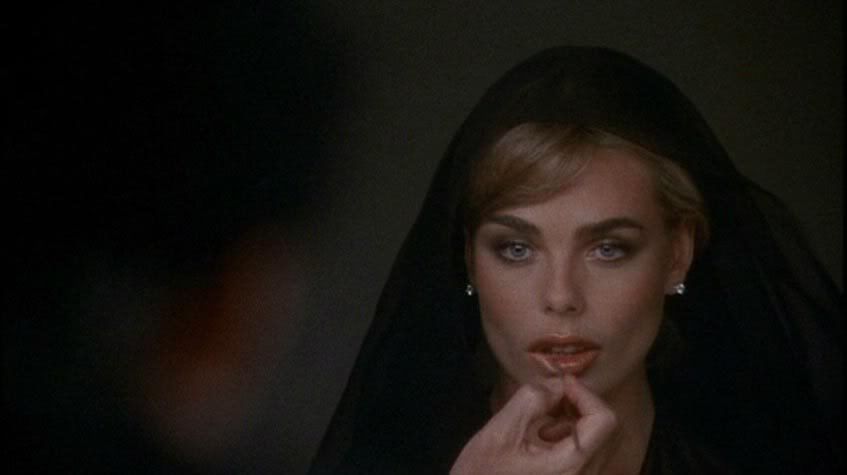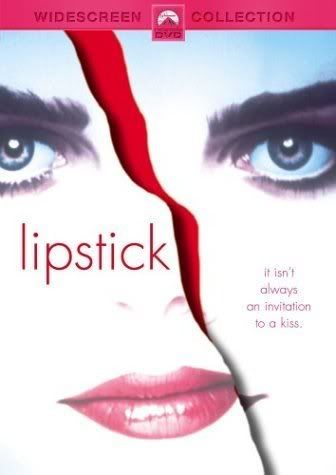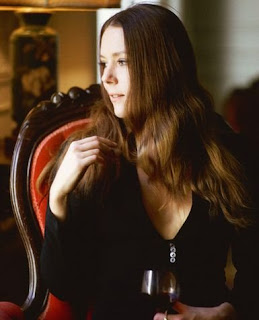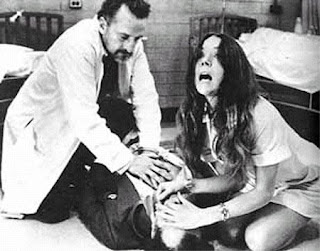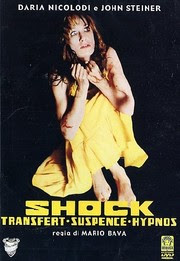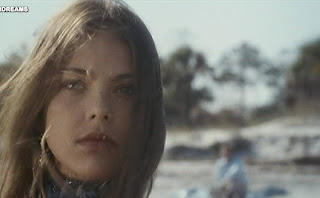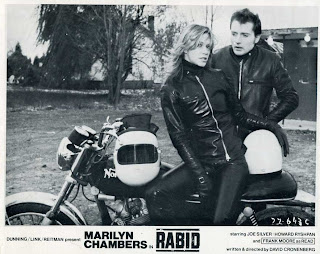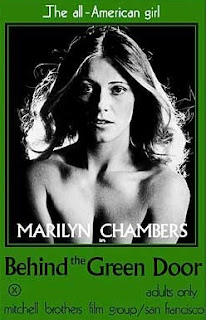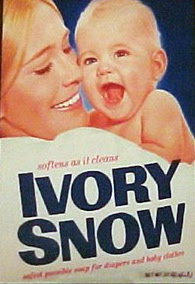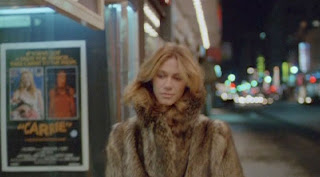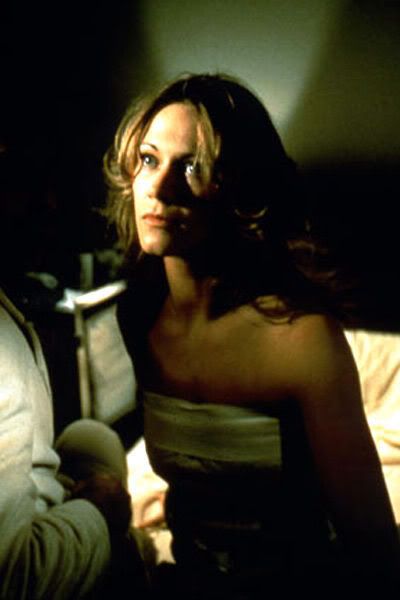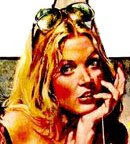
Starting out life as an early story from legendary director John Carpenter entitled
Eyes, Irvin Kershner’s
Eyes Of Laura Mars remains one of the slickest and most effective American thrillers of the late seventies. Bolstered by an intense lead performance by Faye Dunaway and some very memorable photography by Helmut Newton,
Eyes Of Laura Mars was a fairly big hit back in 1978 but is often overlooked as one of the more memorable films of the period.
Carpenter had come up with the idea for
Eyes, about a controversial fashion photographer who can psychically see through the eyes of killer while he is murdering her friends and coworkers, when he was working on spec scripts in the early and mid seventies. After the mammoth success of
Halloween, producer Jon Peters bought Carpenter’s story for Columbia Pictures and brought the famed director on board to work on his first major studio film...as its screenwriter.
Carpenter did indeed delver a version of
Eyes Of Laura Mars but Columbia wasn’t totally compelled by it so they brought in David Zelag Goodman in to touch it up. The Academy award nominated Goodman is best known for his work on Sam Peckinpah’s
Straw Dogs (1971) and the Sci-fi classic
Logan’s Run (1976) and his work on
Eyes Of Laura Mars remains a point of contention among fans of the film.
Peter’s and Columbia had originally envisioned
Eyes as a vehicle for mega-star Barbra Streisand who was fresh off fan favorite
A Star Is Born (1976). That idea fell through, although Streisand would end up playing a rather pivotal role in
Eyes Of Laura Mars, and Faye Dunaway was hired on instead.

Dunaway, at the time, was rightly considered one of the greatest actresses in Hollywood. She had just had the one-two knock out punch of Roman Polanski’s
Chinatown (175) and Sidney Lumet’s
Network (1976) and had in fact just won the Academay award for the latter production. Dunaway, nearing forty when she made
Eyes Of Laura Mars, was at her absolute height and as Mars she gives one of her great performances, even though it too has its critics.
Future
Empire Strikes Back (1982) director Irvin Kershner is often undervalued and
Eyes Of Laura Mars is definitely one of his more notable achievements.

Kershner got his start in the fifties with such big screen productions like
Stakeout On Dope Street (1958) and several popular television productions. This alternating between TV and film would continue throughout the sixties for Kershner where along the way he would garner a few Emmy nominations for his work on the small screen.
Kershner’s most popular film work leading up to
Eyes Of Laura Mars were several off the wall dark comedies including
A Fine Madness (1966),
The Flim-Flam Man (1967) and
Up The Sandbox (1972).
Sandbox would star Streisand herself in one of her wackiest roles which makes the idea of her in Mars even more intriguing. After the terrific
S*P*Y*S in 1974 and the Richard Harris vehicle
The Return Of A Man Called Horse (1976), Columbia and Peters approached Kershner with the idea of doing
Eyes, a film which would turn out to be his first near all out thriller, and he accepted fairly quickly.
Kershner’s work in
Eyes Of Laura Mars is one of its biggest assets. Adapt at building a real sense of dread in the film’s more eerie moments, Kershner also lends his excellent comic hand in the film’s lighter and more human points. His work throughout the film lends it a most distinctive air, almost like a glossy big studio American Giallo. It has that same seductive blood soaked feel about it, something very few American thrillers have ever achieved.
Joining Kershner behind the scenes are Cinematographer Victor J. Kemper, who I just recently wrote about in my look at Arthur Hiller’s
The Hospital (1972) and designers Gene Callahan (Art) and Robert Gundlach (Production). Gundlach had just come off a heavy duty job as art director on Robert Guillerman’s
King Kong remake in 76 and fittingly
Eyes Of Laura Mars resembles the second half of that ambitious and undervalued film perhaps more than any other.

Since
Eyes Of Laura Mars is a film set in the fashion world a look at the costume design of the film is warrented and famed designer Theoni V. Aldredge definitely comes through big time with Kershner’s film. Everyone in the film is decked out in some of the most memorable outfits of the period with special mention going to the absolute gorgeous and sexy dresses Aldredge gave Dunaway. It’s stirring work from the multiple Tony and Oscar winning designer and it is a shame that the Academy didn’t at least honor her with a nomination for her work on
Eyes Of Laura Mars. She did win a well deserved Saturn Award for the film though.
Legendary and controversial photographer Helmut Newton was hired on by Columbia to shoot the pictures of Laura Mars and his work in the film unforgettable, with his violent and sexy fetishistic photos connecting the film even more to the works by Italian maestros like Sergio Martino and especially Dario Argento. Some of the more striking photos do indeed look like they could be stills from some of the more provocative Italian productions from the early seventies.
Eyes Of Laura Mars would mark the first, and unfortunately, final time Newton would lend his unmistakable eye to a film, a fact that alone makes
Eyes Of Laura Mars and important work.

Moving along at a lightning pace, thanks to the quick cutting styles of Spielberg editor Michael Kahn, and scored expertly by Artie Kane,
Eyes Of Laura Mars is at the very least one of the most entertaining American films of the late seventies. It is also one of the most interesting, perhaps even more so today as our culture has become so saturated by the type of violent and sexual images the film is dealing with. One can see the influence of Newton’s photography everywhere now, from advertisements to film to video, and the questions the film raises about why we are so attracted to such images remains a valuable one.
Joining the rather breathtaking Dunaway is future Oscar winner Tommy Lee Jones, who was just on the brink of stardom here. As the police detective Mars falls for, Jones is very sharp, handsome and justifiably intense. One reason the film’s payoff is so good is due to the amount of humanity and natural charisma that Jones brings to the role. Watching it today, it is impossible to think of anyone else in it. Rounding out the supporting cast are several truly gifted character actors, including scene stealer Rene Auberjonois, Brad Dourif and Raul Julia. Auberjonois is particularly good here and gives the film several brief comic interludes that Kershner works into the proceedings seamlessly.
The models themselves are, of course, all quite striking, with special mention going to both Darlanne Fluegel’s Lulu and Lisa Taylor’s Michele. One of the film’s biggest triumphs is that it allows these models to feel like real people. So often films centering in the fashion world are hampered by weak characterizations but both Fluegel and Taylor are given some wonderful scenes to work with here which makes their murder sequence one of the most spellbinding and moving.

They would both appear in a 1978 Playboy spread advertising the film which I have unfortunately not seen.
The thing that I like most about
Eyes Of Laura Mars, and the thing that I think separates it from most thrillers from the period, is the way it deliberately dismantles itself just past the middle point. It is easy to look upon the rather forced relationship between Dunaway and Jones as just a stab to bring more people into the theater, but by shifting the tone of the film from hard edged thriller to near sappy romance, Kershner is able to brilliantly set up one of the best pay offs in late seventies American cinema. The rather awkward romantic scenes between Dunaway and Jones only make sense and have a resonance about them after the film has ended, which helps the film gain strength in its reviewings. Kershner is a smart filmmaker and, less a commercial ploy, the sudden switch in tone in the film is actually quite clever.
It is that switch that I believe John Carpenter and many critcs don’t like about the film. Carpenter would have made
Eyes Of Laura Mars a much more straight ahead and go for the throat thriller but Kershner seems much more interested in manipulating the audience in different ways. I think Carpenter’s film would have been a real winner, but that shouldn’t take away from Kershner’s work.
Another aspect that has divided fans of the film is the themes song by Streisand that plays at the beginning, end, and at various points throughout the film. I happen to adore the song and think it is one of Streisand’s career defining performances.

It also happens to fit the film and Laura Mars character perfectly and I frankly can’t imagine the film without it. Still, it remains a sore spot to some who see
Eyes Of Laura Mars as nothing but a slick and pandering piece of commercial filmmaking.
Eyes Of Laura Mars opened in the late summer of 1978 and was a sizeable hit. Critical reaction was mixed but the fans ate it up and it grossed three times its budget throughout the late part of the year. It would also do well in Europe, especially in France where Carpenter’s inventive original story and Kershner’s stylish direction caught the eye of several prominent film critics.
Carpenter has all but disowned the film and has been very vocal about his dislike for the final product. Dunaway would have a couple of minor hits in the late seventies before her career was pretty much destroyed after the disastrous reception that greeted 1981’s ill fated
Mommie Dearest. Although she still acts to this day,
Eyes Of Laura Mars remains her absolute peak as one of the screen’s great performers and beauties.

Kirshner began work on
The Empire Strikes Back right after production on
Eyes Of Laura Mars wrapped and his work on that film would be just as spectacular and innovative. His career after is unfortunately scatter shot with only the unofficial James Bond picture
Never Say Never Again really show flashes of his obvious brilliance again (although some could make a case for his
Robocop 2 as well).
Eyes Of Laura Mars is a rare breed of commercial filmmaking. Like the memorable photographs that Mars takes in the film, there is a lot more to it than just an average middle of the road thriller. Drawing on a real palatable aesthetic, Kershner’s film feels as fresh, alive and as sinister as it did thirty years ago. The current DVD of it features a solid commentary from the director, a vintage behind the scenes feature called
Visions and the participation of important DVD producer Laurent Bouzereau who rightly puts the film in its place as one of the most under looked classics of late seventies American cinema.



